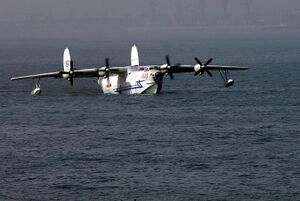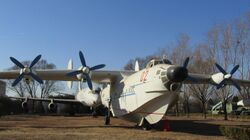Engineering:Harbin SH-5
| SH-5 | |
|---|---|

| |
| Role | Maritime patrol amphibian/air-sea rescue |
| Manufacturer | Harbin Aircraft Factory |
| First flight | 3 April 1976[1] |
| Introduction | 1986 |
| Primary user | People's Liberation Army Naval Air Force |
| Produced | 1984-1985 |
| Number built | 7 [2] |
The Harbin SH-5 (Chinese: 水轰五型; pinyin: Shuǐhōng wǔxíng; literally: 'water bomb type 5', where "水轰" is short for 水上轰炸机; Shuǐshàng hōngzhàjī; 'seaborne bomber') is a Chinese maritime patrol amphibious aircraft intended for a wide range of duties, including aerial firefighting, anti-submarine warfare (ASW) and air-sea rescue (ASR). One prototype and six production aircraft have been built.
Design and development
Research to build a seaplane capable of replacing Beriev Be-6s in service was initiated by the PLANAF in 1968, with designers reassigned from "Objective 3/17", a supersonic canard-wing fighter project. The first prototype flew in 1976; further units were delivered between 1986 and 1990.
Variants
- SH-5B Firefighter
- One SH-5 was rebuilt for firefighting duties.[2]
- However, by Chinese source,[3] there were total of 7 SH-5 were produced: 3 SH-5X Prototype, 3 Maritime patrol aircraft, and 1 SH-B Firefighter.
Operators
 People's Republic of China
People's Republic of China
- People's Liberation Army Naval Air Force received 4 aircraft in 1986.[2] All are operated by the People's Liberation Army Navy North Sea Fleet from an aircraft base near Qingdao, Shandong province.[4]
Specifications (SH-5)
Data from Jane's Aircraft Recognition Guide,[5] Jane's All the World's Aircraft 1988-89[6]
General characteristics
- Crew: 8
- Capacity: 10,000 kg (22,000 lb) maximum payload (cargo), 6,000 kg (13,000 lb) maximum weapons load
- Length: 38.9 m (127 ft 7 in)
- Wingspan: 36 m (118 ft 1 in)
- Height: 9.79 m (32 ft 1 in)
- Wing area: 144 m2 (1,550 sq ft)
- Empty weight: 25,000 kg (55,116 lb) SAR (Search And Rescue) and Transport
- 26,500 kg (58,400 lb) ASW (Anti-Submarine Warfare)
- Gross weight: 36,000 kg (79,366 lb)
- Max takeoff weight: 45,000 kg (99,208 lb)
- Fuel capacity: 16,500 kg (36,400 lb) max
- Powerplant: 4 × Dongan WJ5A turboprop engines, 2,350 kW (3,150 hp) each
- Propellers: 4-bladed constant speed reversible propellers, 3.8 m (12 ft 6 in) diameter
Performance
- Maximum speed: 560 km/h (350 mph, 300 kn)
- Cruise speed: 450 km/h (280 mph, 243 kn) maximum
- Min Patrol speed: 230 km/h (120 kn; 140 mph)
- Take-off speed (water): 160 km/h (86 kn; 99 mph)
- Landing speed (water): 92 km/h (50 kn; 57 mph)
- Range: 4,756 km (2,955 mi, 2,568 nmi) with maximum fuel
- Endurance: 15 hours on two engines
- Service ceiling: 10,250 m (33,630 ft) service ceiling
- Rate of climb: 9 m/s (1,800 ft/min)
- Wing loading: 250 kg/m2 (51 lb/sq ft) at 36,000 kg (79,000 lb)
- 312.5 kg/m2 (64 lb/sqft) at 45,000 kg (99,000 lb)
- Power/mass: 0.302 kW/kg (0.184 hp/lb) at 36,000 kg (79,000 lb)
- 0.242 kW/kg (0.147 hp/lb) at 45,000 kg (99,000 lb)
- Take-off run (water): 548 m (1,798 ft)
- Landing run (water): 240 m (790 ft)
Armament
- Hardpoints: 4 with a capacity of 6,000 kg (13,000 lb) of C-101 ASMs, ASW torpedoes, depth charges; mines; bombs,
Avionics
Doppler search radar in nose radome; MAD (Magnetic Anomaly Detector) boom extending from the tail of the fuselage
See also
Aircraft of comparable role, configuration and era
References
- Notes
- ↑ John Pike. "PS-5 / SH-5 - Shuishang Hongzhaji (Maritime Bomber)". http://www.globalsecurity.org/military/world/china/sh-5.htm.
- ↑ 2.0 2.1 2.2 "The Shin Meiwa PS-1 / US-1 / US-2 & Harbin SH-5 Flying Boats". http://www.airvectors.net/avps1.html.
- ↑ "某型水上飞机水动力性能数值验证研究". http://cdmd.cnki.com.cn/Article/CDMD-10487-1013015208.htm.
- ↑ "shenzhou_01". SinoDefence. http://www.sinodefence.com/airforce/specialaircraft/sh5.asp.
- ↑ Rendall, David (1995). Jane's Aircraft Recognition Guide. Glasgow, UK: HarperCollinsPublishers. pp. 505. ISBN 978-0-00-470980-2. https://archive.org/details/janesaircraftrec0000rend/page/505.
- ↑ John W.R. Taylor, ed (1988). Jane's all the World's Aircraft. London: Jane's information Group. ISBN 0-7106-0867-5.
- Bibliography
- Rendall, David (1995). Jane's Aircraft Recognition Guide. Glasgow, UK: HarperCollinsPublishers. pp. 505. ISBN 978-0-00-470980-2. https://archive.org/details/janesaircraftrec0000rend/page/505.
- John W.R. Taylor, ed (1988). Jane's all the World's Aircraft. London: Jane's information Group. ISBN 0-7106-0867-5.
- The Harbin SH-5
- 某型水上飞机水动力性能数值验证研究
- PS-5 / SH-5 - Shuishang Hongzhaji (Maritime Bomber)
- SH-5 Amphibious Aircraft, Chinese Defence Today
 |


